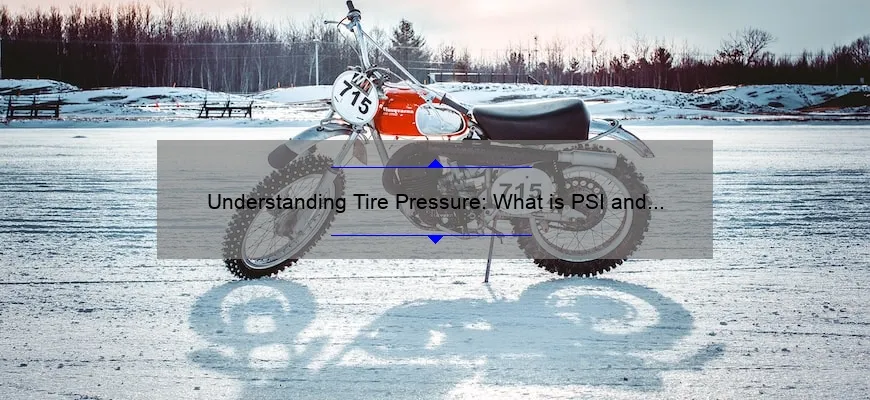Short Answer: What is the PSI on a Tire?
PSI, or pounds per square inch, refers to the amount of air pressure in a tire. The recommended PSI for a tire can typically be found on the vehicle manufacturer’s placard located inside the driver’s side door jamb or in the owner’s manual. Proper inflation helps ensure optimal handling, fuel economy and tire longevity.
Step by Step Guide: How to Check the PSI on Your Tires
Checking the PSI, or pounds per square inch, on your tires may not be the most exciting task in the world, but it’s a crucial one. Having properly inflated tires is important for not only ensuring safety while driving but also increasing fuel efficiency and prolonging the life of your tires.
Without further ado, here’s a step-by-step guide to help you check the PSI on your tires:
Step 1: Gather Your Tools
You will need an accurate tire pressure gauge and a source of air (either an air compressor or manual pump).
Step 2: Check Recommended Tire Pressure
Before checking the actual PSI of your tires, it’s essential to know what pressure they should be at according to your car manufacturer’s recommended specifications. You can find this information either in the owner’s manual or on a sticker located inside one of the front doors.
Step 3: Check Tire Temperature
Tire pressures can change with temperature fluctuations so if you have been driving around; check them when they are relatively cold since hot surfaces would raise their pressure level inaccurately.
Step 4: Remove Valve Cap and Attach Gauge
Remove valve cap from each tire by twisting it counter-clockwise by hand. In order to get an accurate reading firstly attach gauge onto valve stem firmly without causing any leaks.
•Tip! Don’t rush needle doesn’t settle immediately give few seconds till stable readings appear.
Step 5: Note Reading & Fill Up Air If Required!
Now check measuring numbers under pins that show up once stuck properly into stems which represent current value roughly compared with mandatory values stated by automaker like let say its ideal number Range-28 psi -32 psi then adjust accordingly… At some cases over-inflated requires letting out slightly less volume through valve whereas underinflated imitates adding more until reaching optimal levels…
Finally replace dust caps back and repeat at all wheels if possible every month as continued monitoring assists longevity though operational efficiency also ensures significant fuel economy, prevents flats or accidents due to poor grip.
Now that you know how to check the PSI on your tires, it’s time to get out there and put your newfound knowledge into practice!
FAQs About Tire Pressure: Everything You Need to Know about PSI
As a responsible car owner, it’s essential to know the ins and outs of tire pressure. Underinflated or overinflated tires are not only dangerous but can also cause premature wear and tear on your vehicle, leading to costly repairs in the long run.
In this blog post, we’re going to answer some frequently asked questions about tire pressure that every driver should be able to address confidently.
1. What is PSI?
PSI stands for pounds per square inch – the standard unit of measurement for tire pressure. It refers to how much air is inside your car’s tires.
2. How do I determine my recommended PSI?
The recommended PSI will depend on a variety of factors such as your vehicle make and model, tire size, load weight, among others. You can find this information in several places: your car manual, door jamb sticker or label on the gas cap lid.
3. Is there any way I can tell if my tires are under-inflated by simply looking at them?
If you observe that your car seems tilted from one side while parked that could indicate under-inflation in one of its tires When inspecting visually look for an abnormal bulge or dent along with the treadline; that too could allude towards low enough inflation levels impacting its sturdiness
4.What problems does poor tire pressure cause?
Low-pressure conditions place excess stress upon each set leading usage extending deterioration & quicker lifespan inadequacies create higher friction points thus lowering vehicular inspection performances even suddenly accelerating itself appears extra tough when wheels remain between 10-15 tilts below typicaal limit
5.When must I check my tire pressure readings?
It is best advised once every 45 days detailed visual evaluations ought kick off so correcting volume formlessness mismatch happens sooner If undergoing severe weather extends interval timing slightly ensuring driving safety without delay
6.How regularly should i rotate & exchange old tyres?
Frequency of rotation differs from vendor specifications note components life span limits,for instance Japense makes like Toyota initiate this process every 5K (kilo) miles in contrast to domestic brands who suggest doing so as proportionate; be wary regarding leakages or sustained punctures before deciding removing the tyre out
7.How can I maintain good tire pressure?
Tire safeguards stipulate that you ought to pay heed when filling-up air volume each month for both frontside & back tyres In addition during extreme weather deviations keep a tight check on elevations possible yet unnecessary faults equal heavy monetary expenses in service repair centres. Hence pre-checking of depeciation marks,dirt accumulation should become monthly practice.
In conclusion, tire safety is critical to avoiding accidents and saving up time and long-term maintenance costs. Keeping your tires inflated at the recommended PSI levels will not only provide a smoother riding experience but also guarantee better fuel-efficiency maximizing savings on regular gas refilling visits.Allow it to undergo inspections timely by yours truly tech experts delivering reliable skillsets giving rise towards avoidance of everyday hazards down the path ahead.
Top 5 Facts You Didn’t Know About PSI on a Tire
For most people, a quick glance at their car’s tire pressure gauge is enough to make sure it’s running smoothly. However, few know what PSI really means and its impact on the overall performance of their vehicle.
Here are five facts about tire PSI you probably didn’t know:
1) The Recommended Tire Pressure Varies Depending on Several Factors
The recommended tyre pressure for your vehicle usually varies depending on factors such as size, weight distribution, speed rating and load capacity. It’s essential that you consider these factors before determining the optimal tyre pressure for your specific model.
2) Low Tire Pressure Can Affect Fuel Efficiency
When tire pressures drop below recommended levels they increase rolling resistance leading to higher fuel consumption by up to 6%. Over time this can result in increased costs unnecessarily incurred through wasted energy resources which could have been saved with proper attention being given beforehand!
3) Underinflated Tires Increase Risk of Blowouts
Driving on tires devoid of appropriate atmospheric pressure exposes drivers to varied risks including blowouts. Vehicles become harder to handle due to poor steering control caused by friction increases from contact between underinflated tires and pavements.
4) Handling Performance Decreases with Over-inflation
On the other hand, over-inflation results in an uneven spread of surface area when in contact with pavements causing a reduction in handling performance when turning corners or taking bends hence exposing cars occupants’ safety risk due accidents resulting therefrom like unwanted drifting etcetera
5)Licensed Mechanic Will Ensure Your PSI Are Accurate
Certified professional mechanics have both training experience expected qualifications They will check out all aspects necessary ensuring optimal results obtained possible: torque specs peripherals supported consistency maintenance checks performed accordingly During routine inspections done regularly certified technicians highlight decreasing performace while acting proactively This ensures high degree prevention keeping peace mind knowing well-maintained vehicles pose fewer threats road user invariably reduced liabilities encountered beforehand despite initial investments realized after relevant repairs done.
In conclusion, tire PSI plays a crucial role in ensuring the safety and efficiency of your vehicle. It’s essential to monitor tyre pressure regularly and adhere to manufacturer recommendations; licensed mechanics can assist with inspections stress-free save time money while reducing risk liabilities associated wrongful occurrences inherent on top overlooked issues catalyzed by underestimating apparent insignificance which might bring about unwanted inconveniences if not put into perspective beforehand whereby resultant benefits outweighing incurred expenses significantly established afterwards through swift actions taken proactively…and that’s why investing in professional maintenance will ultimately pay off!








